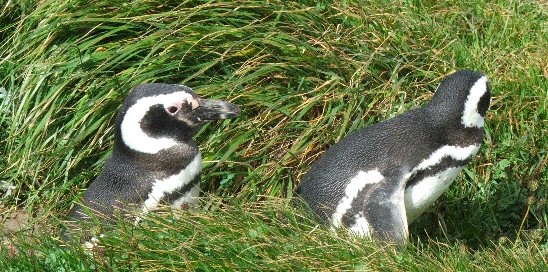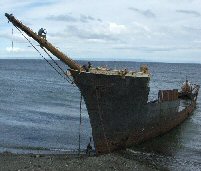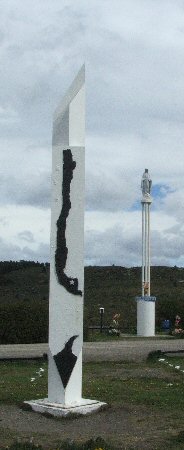Chapter Two - Punta Arenas, Magellan Straits
The
following day we decided to head in the opposite direction & take a trip
to the head of the Magellan Straits, but not before paying a visit to a small
penguin colony not far from Punta itself, driving through the quarried landscape
to get the colony we were half expecting to find not a lot, when we did arrive
we found a really inconspicuous set up, timber covered paths wound their way
through the dunes to occasional viewing platforms giving fantastic views of
the Magellanic penguins without appearing to disturb or interfere with their
daily existence.
Now before visiting the colony the only penguins I'd ever seen were the those seen swimming in dirty water behind glass so at the zoo so it was pretty dam amazing to see these bizarre creatures in their natural enviroment. As you can imagine a great many photographs were taken of the penguins themselves as well numerous other birds that just happened to be passing at the time including an enormous condor.


Whilst coming away from the colony we were met with the sight of a herd of cattle being driven over the horizon by a group of goucho's down to the sea presumably for water, it was pretty cool to see how thier dogs worked the beef without getting stomped on.
Anyway after leaving the penguins & Goucho's behind we turned tail & headed for the Magellan Straits. Cutting back through down town Punta you get a real appreciation for just how big the city is, Punta is the third largest city in the entire Patagonian Region, after the more northerly Argentine cities of Neuquén and Comodoro Rivadavia. Figures vary but in 2002, it had recorded of 120,000, this feels, compared to the area it covers, incredibly low & given the sprawling tin suburbia that exists beyond the central zone it does seem like a underestimation.
Once you get out of the main plaza the city quickly takes on a very urban laid
back feel, I don't know what the cost of living's like for locals but as a visitor
your money goes a long way, especially dollars. Anyway, heading for the straits
the road rapidly returns to dusty crushed stone. On route there are numerous
rotting ship's carcass's & boulder strewn dried up river beds running down
to the coast that in winter become raging torrents, back in town, the main water
course has been housed in a concrete culvert, in December there was only a trickle
of water dribbling down to the sea however it was pretty choked up from the
winter run off which annually has to be excavated out.
An hour or so later, we found ourselves at the end of the road, literally, overlooking the head of the straits from Fuerte Bulnes.


Reconstructed over the original remains in the early 1940's & declared a national monument in 1968 the Chilean fort located overlooking the Strait of Magellan was originally founded in 1843 over a rocky hill at Punta Santa Ana, under the command of President Manuel Bulnes Prieto. The fort's construction was a consequence of the colonisation policies in Southern Chile. Chilo's intendant Domingo Espieira Riesco ordered the construction of a schooner named after the President himself, but its name was changed to "Goleta Ancud" by Bulnes in order to reflect the origin of the ship. It sailed from Ancud on May 22nd 1843, under the orders of Captain Juan Williams (changed to Chilean version Juan Guillermos, under which name he signed documents), and it arrived at Punta Santa Ana on September 21st 1843, about 2 km from Puerto del Hambre.

At this place the fort was built, using mainly logs and dirt & grass 'bricks'. Due to the harsh weather, it was not possible to gather a large and stable population. As a result, after six years of struggling to establish a town in that area, Punta Arenas was founded in the Sandy Point area in 1848. Once people finished moving and settled down in Punta Arenas, the fort was left aside, even being lit by Lieutenant Cambiazo.
Next to the fort there's a little cafe, its not posh & its about as far from a McDonalds as you can get, hurrah, but the old chap who runs it's a star, he makes fantastic hot & spicy epanadas, absolutely bloody marvellous.

 After
a very enjoyable lunch & a good mouch around the fort we piled into the
pick ups & headed back towards Punta, on route we stopped in Puerto del
Hambre. This Spanish settlement was founded in March 1584 by Pedro Sarmiento
de Gamboa as the city of Rey Don Felipe with around 300 settlers, but conditions
were harsh and local vegetation was sparse. This attempt to colonise the shores
of the Strait ended tragically when the settlers starved or froze to death,
and when the English navigator, Sir Thomas Cavendish landed at the site in 1587
he found only ruins of the settlement. He renamed the place Port Famine, and
under this name it later became a base used by the British Royal Navy. There's
not a great deal to see there now, a few homesteads, a population who play duelling
banjo's as well as a monument to the dead, although we did see several Buff
necked Ibis.
After
a very enjoyable lunch & a good mouch around the fort we piled into the
pick ups & headed back towards Punta, on route we stopped in Puerto del
Hambre. This Spanish settlement was founded in March 1584 by Pedro Sarmiento
de Gamboa as the city of Rey Don Felipe with around 300 settlers, but conditions
were harsh and local vegetation was sparse. This attempt to colonise the shores
of the Strait ended tragically when the settlers starved or froze to death,
and when the English navigator, Sir Thomas Cavendish landed at the site in 1587
he found only ruins of the settlement. He renamed the place Port Famine, and
under this name it later became a base used by the British Royal Navy. There's
not a great deal to see there now, a few homesteads, a population who play duelling
banjo's as well as a monument to the dead, although we did see several Buff
necked Ibis.
On route back to the hotel we made one last stop at the Centro Geografica de Chile, basically this is, according to Chiliean patriots, the central point of Chilean territory North to South, its only when you look at the map on the monument that you realise that this includes thier claim on Antarctica. Well fair enough I suppose, after all isn't that just like Blighty ? dead right it is, but its even more like Blighty than I first thought as the Chileans claim just happens to overlap that area that Britain claims soveriegnty over, so its not just the Argentineans that want the same slice of pie.
Well
there's not a huge deal more for me to say about Punta Arenas as the CAA finally
signed all the correct bits of paper before we could explore further. I did
of course do the tourist bit & bought the kids a couple of T Shirts, Patagonia
style, as well as Club Social y Deportivo Colo Colo football shirts, had a wander
around the cemetries, pretty interesting, explored the docks & sin city,
wandered up Cerro Mirador, pretty good views over the city, & enjoyed the
local hospitality. A couple of us also wangled a tour of the Chilean equivilant
of British Antarctic Survey, the Instituto Antarctico Chileno, the door of which
proudly displays the Chilean claim on Antarctica as did the kids pictures inside.

All in all Punta Arenas was a pretty interesting place & whilst the delay
caused a lot of hassle workwise it was a pretty enjoyable stop over & a
place I'd be happy to visit again some time, check out "Black Sheep"
it's a free independant rag aimed at those travelling around Chilean Patagonia,
its definately worth a read.